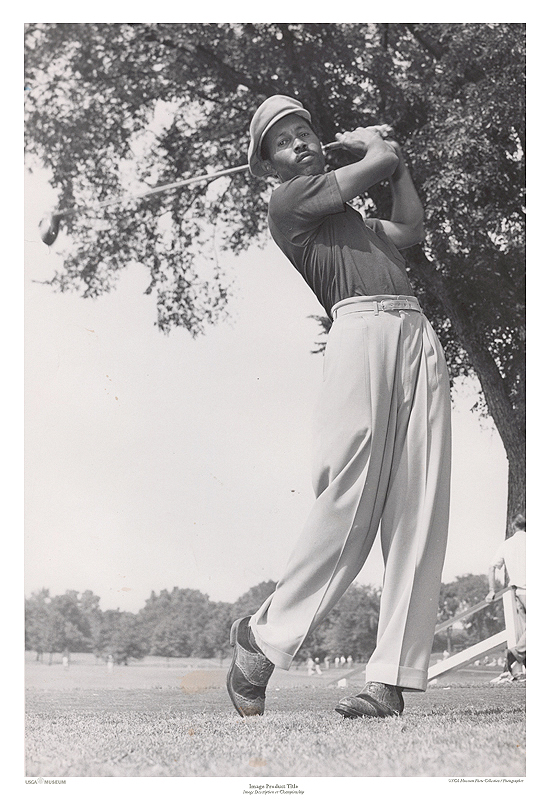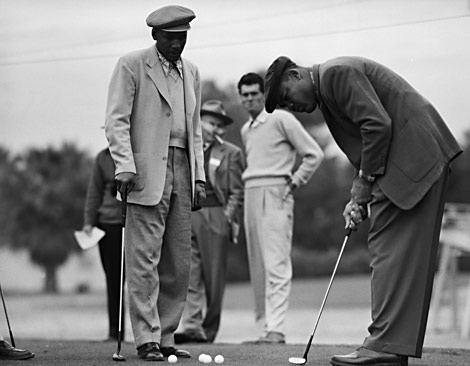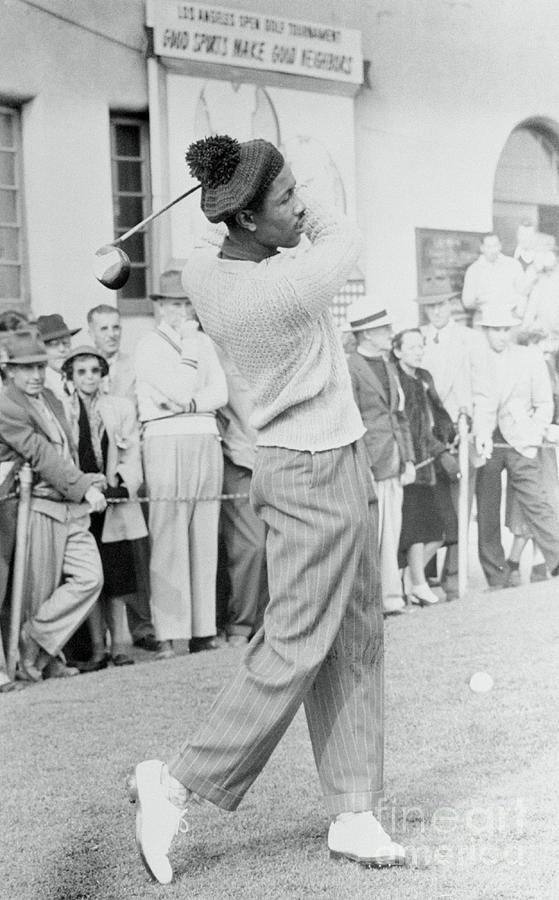On the first hole of a Monday qualifier for the 1952 Phoenix Open, Ted Rhodes and two other Black golfers found a pile of human feces in the cup. This humiliating act of racism was not new to Rhodes, who four years earlier had achieved widespread recognition for competing in the L.A. Open and U.S. Open. Yet he persisted in playing the game he loved.
Rhodes’s life in and out of golf demonstrates the narrow path Black men had to walk in a violent and segregated country. He died on July 4, 1969—incidentally, the day Americans celebrate their rights. Rhodes, like most other Black Americans of his generation, never saw his own rights realized. While his legacy in golf is cemented, marking a straight line to Lee Elder, Charlie Sifford, Calvin Peete, and Tiger Woods, Ted Rhodes’s life and struggles have not received as much recognition as they deserve.

Ted Rhodes at Tam O'Shanter Country Club in 1952 (USGA Museum)
◊
Ted Rhodes was born to Frank and Della Anderson Rhodes in Nashville, Tennessee, 44 years after the Civil War ended. He taught himself golf, using discarded clubs to hit shag balls on a privately owned, segregated park 20 miles east of the city. He caddied at a private club that, two generations before, was home to 136 enslaved people.
To understand Tennessee at the turn of the 20th century, you have to know something about the history of the Jim Crow South.
After the end of post-Civil War Reconstruction in 1877, Southern states revised their constitutions, adding segregation clauses and drafting laws that defined Blacks as second-class citizens. These are now known as Jim Crow laws. They prevented legal, social, and economic mobility for Black Americans, effectively recreating the plantation system by making Black laborers dependent on white landowners. The laws existed in one form or across the South—as well as across much of the U.S.—until the modern Civil Rights Movement in the 1950s.
But there were other kinds of oppression, too. In 1867, the Ku Klux Klan held its first national meeting in the Maxwell House Hotel in Nashville. The KKK was a collection of Confederate veterans who used violence and the threat of violence to prevent Blacks from voting and to enforce white supremacy. By 1915, the Klan had become a violent, militant arm of the Southern Democratic Party.
During this period, lynchings of Black Americans reached an all-time high. According to the NAACP, 177 lynchings occurred in Tennessee between the end of Reconstruction and 1930. Lynchings were more than murders of Black Americans; they involved torture, too. Eyes were gouged, flesh torn with corkscrews, fingers and toes cut at the knuckles to be kept as souvenirs, Black men were disemboweled, and Black women were raped. This violence was intended to intimidate Black people into subservience.
In many cases, lynchings were treated as a town affair. In Memphis, Tennessee, in May 1917, thousands of people came together when Ell Persons was burned alive for allegedly confessing to the murder of a white child. The Memphis Press described the event as having a carnival-like atmosphere.
This is the world Ted Rhodes entered when he was born in Nashville, Tennessee, in 1913.
◊
In the 1920s, there were two golf courses in Nashville. Neither was open to Black players, but Ted Rhodes caddied at both.
Belle Meade Country Club occupies land that used to belong to the Belle Meade Plantation, which was owned and operated by the Harding family: specifically William Harding, his son-in-law William Hicks Jackson, and his son William Harding Jackson. The eldest Harding was a general in the Confederate Army and owned well over 100 Black slaves. Belle Meade, which means “beautiful meadow” in French, operated primarily as a livestock farm until 1864, when the Union Army seized it.
In addition to the country club and a historic site, the property today includes two enormous public parks with streams, rolling hills, and rugged forests.
Belle Meade Country Club was established by Jackson’s descendants in 1901. The course was built in 1912 and redesigned by Donald Ross in 1921. This is where Ted Rhodes fell in love with golf, carrying bags on the same ground where enslaved Black people had toiled just two generations prior.

Belle Meade Country Club today
“He knew he wasn’t allowed to play there,” says Rhodes’s daughter, Peggy Rhodes-White, “but he was going to learn how to play. His boss, the [caddie master], gave him old clubs to practice with. But he also built his clubs, too, out of clothes hangers.”
“Don’t ask me how,” she adds with a laugh.
Rhodes practiced the game wherever he could, but usually at Sunset Park, about 20 miles from Belle Meade. This 11-acre park had a baseball field, a concession stand, and picnic tables. It was owned by a local cobbler who recognized that the Black community in the Nashville area needed a place to gather, and that the city wasn’t providing one.
“He’d hit balls in that old baseball field,” Rhodes-White says. He made pins from sticks and tied cloth around them for flags. “He was born with a knack for it, and it was something he wanted to do.”
Rhodes caddied on weekends and went to Pearl Cohn High School during the week. After graduation, he worked at the Civilian Conservation Corps, which was funded by President Roosevelt’s New Deal. Rhodes was then drafted into the Navy, and he served a tour of duty in World War II.
After his service, Rhodes settled in Chicago, where he connected with Billy Eckstine, a jazz musician and band leader. Eckstine liked golf, but Rhodes knew someone who liked it even more: Joe Louis.
Louis was the heavyweight boxing champion of the world and a national icon. He was also outspoken on social justice issues, using his celebrity to advocate for legal and economic equality for Black people. Louis met Ted Rhodes in 1946 at the Joe Louis Open in Detroit. Right away, it seems, Louis took a shine to the 32-year-old golfer.

Ted Rhodes watching Joe Louis putt
Rhodes was 5’11”, handsome, stylish, and skilled. He soon became Louis’s valet and personal swing coach. In return, presumably, Louis bankrolled Rhodes’s development as a professional golfer. He sent Rhodes to Los Angeles in the late 40s for tutelage under Ray Mangrum, brother of 1946 U.S. Open champion Lloyd Mangrum. While living in Southern California, Rhodes played in some white-run tournaments that allowed Black participation, such as the Tam O’Shanter and the L.A. Open. But most of his competitive action came on the United Golf Association tour.
The UGA was founded in 1926 in response to the exclusionary policies, both written and unwritten, of golf’s governing bodies. Between 1896 and 1948, no Black golfer competed in the USGA’s premier tournament, the U.S. Open. The PGA of America, which ran the PGA Championship and many other professional tournaments, was more explicit in its prohibition, writing a “Caucasians-only” clause into its by-laws.
So for Rhodes, the UGA was a crucial source of opportunity, and he made the most of it. He won regularly, including six times in a row from 1946 to ’47. He claimed four UGA Championships and one National Negro Open Champonship, and, in all, accrued an estimated 150 UGA victories. This is the record that caused Charlie Sifford, another pathbreaking Black golfer, to call Rhodes the “Black Jack Nicklaus.”
◊
Rhodes had an excellent all-around game. He was an outstanding ball-striker who rarely missed fairways, which earned him the nickname “Straight Arrow.” Around the greens, Rhodes was known for his artful short game.
His daughter Peggy Rhodes-White is convinced that the gracefulness of Rhodes’s swing came from one of his favorite hobbies. “He was a great dancer,” she says. “It certainly had to help his swing, keeping his balance and rhythm.”
Rhodes was equally stylish in his manner of dress. He wore dashing, even flashy clothing both on and off the golf course: bright-colored argyle socks, checked shirts under vibrant cardigans, and a pom-pom-adorned Balmoral. “He had golf shoes to match every outfit and color of pants he wore,” Rhodes-White adds. “He prided himself on his dress.” Rhodes’s fashion sense garnered him another nickname, this one ironic: “Rags.”

Ted Rhodes was known for his on-course style
But if his clothes were loud, Rhodes’s personality was the opposite. “He had a naturally calm demeanor,” says Rhodes-White. “It’s something he got from his mother, Della.”
Yet beneath this quiet humility was a burning ambition. “He wanted to be the best golfer in the world,” Rhodes-White says. “Not the best African-American golfer. The best golfer.”
◊
In January 1948, Rhodes earned a spot in the L.A. Open at Riviera Country Club and finished 21st. That performance got him into the Richmond Open in Richmond, California. After a Tuesday practice round at that event, however, Rhodes was informed that he had been barred from competition. Fellow Black golfer Bill Spiller was told the same. The reason? Neither Rhodes nor Spiller was a member of the PGA of America, which co-sanctioned the Richmond Open. Of course, neither man could have been a member because of the PGA’s “Caucasians-only” clause.
According to a 2008 Golf Digest article by Al Barkow, Rhodes was willing to leave, but Spiller wasn’t. Both ended up hiring Jonathan Rowell, a white lawyer in the Bay Area, to sue the PGA for $315,000. Rowell brokered an informal deal: he would drop the suit if the PGA agreed not to discriminate on the basis of race any longer. But nothing was put in writing, and the PGA simply advised its sponsors to rechristen any “Opens” as “Open Invitationals.” Rhodes and Spiller were not able to play in a PGA event again until 1952.
The contrast between Ted Rhodes and Bill Spiller is instructive. Spiller was outspoken in his fight against injustice. One time he established a one-man picket line outside a PGA event. On another occasion, during a meeting with PGA president Horton Smith, Joe Louis, and several attorneys, Spiller suggested he’d be willing to settle things with a boxing match between himself and Smith. Spiller’s son told Al Barkow that Spiller often carried a gun. He never used it—just “pulled it a time or two.”
Rhodes, in contrast, was described this way in Charlie Sifford’s autobiography Just Let Me Play: “Although he tried a couple of times to break into the PGA Tour, [Rhodes] was just too nice a guy and too much a gentleman to fight and scratch for his constitutional right to play. Teddy didn’t want any of that pushing and pressing that it took to break into the game. It was contrary to his nature.”
◊
All the while, Rhodes continued to play exceptional golf. In 1948, he won multiple times on the UGA, traveling between events in a Buick that Joe Louis had bought him.
Amidst his lawsuit against the PGA, he qualified for the U.S. Open at Riviera Country Club and posted an opening round of 70, which was good enough for T-5. He made the cut with a second-round 76, and ended up T-51 for the tournament. Rhodes had competed against the best, and he had acquitted himself well.
In 1952, Rhodes was invited to try to qualify for the Phoenix Open alongside Sifford and Eural Clark. That’s when the group found human feces in the cup on the first green.
Rhodes refused to get angry. He once told Maggie Hathaway of the L.A. Sentinel, a Black-owned weekly newspaper, that “to get angry was the equivalent of losing your game.” Hathaway added, “Getting angry made him so nervous that sometimes he drew his putter back and couldn’t bring it forward.”
At the Phoenix Open, Rhodes was the only one of his group to qualify for the tournament, and he fired a first-round 71 and made the cut. It was one of 69 PGA events Rhodes competed in and one of 20 cuts he made.
◊
Rhodes played professional golf until a kidney ailment sapped him of his energy. He returned to Nashville, where he gave guidance to many Black golfers and received visits from the likes of Joe Louis; Lee Elder, whom Rhodes mentored for three years in L.A.; and Althea Gibson, the five-time Grand Slam-winning tennis player who, incredibly, was also the first Black golfer on the LPGA Tour.
When the PGA of America abolished its whites-only barrier in 1961, Rhodes was 48 years old and well past his prime. The Senior Tour wasn’t established until 1980, when Rhodes, if he had lived that long, would have been 67. As Sifford put it in his book, “Poor Teddy just came along 20 years too soon to be a black man in professional golf.”
Rhodes died of kidney disease at the age of 56 on July 4, 1969.
◊
Ted Rhodes’s legacy is much like the man himself: quiet, persistent, and deeply rooted in his hometown.
Two months after he died, Cumberland Golf Course in Nashville, Tennessee, was renamed Ted Rhodes Golf Course. Sitting on the banks of the Cumberland River, Ted Rhodes GC was the fourth municipal golf facility built in Nashville, and the only one that served Black players. These days, it is the home of the Duffers Golf Association, which hosts an annual fundraiser for a sickle cell anemia charity and supports Meharry Medical College, a historically Black medical school in Nashville.
Golf Legend Ted Rhodes Granddaughter at the Ted Rhodes Golf Course in Nashville.#tedrhodes,#blackgolf pic.twitter.com/Ajvhlq5Dzg
— Ted Rhodes Foundation Inc. (@TedRhodesGolf) September 5, 2014
In 1994, Rhodes’s daughter started the Ted Rhodes Foundation, which works to maintain his legacy and promote minority golf at the local level.
“You know, even a lot of people in the Black community don’t know about his accomplishments,” says Tiffany White, the current CEO of the foundation and Rhodes’s granddaughter. “We want to move the game forward with more minority golfers. Each year we host two tournaments, one in Nashville and one in Chicago for adults and youth. We partner with local HBCU, Fisk University. [The foundation] donated $3,000 to their golf program. And we partner with the First Tee of Nashville to give children of all races more opportunity to compete.”
Such is the long-range impact of Rhodes’s life. He didn’t solve racism in golf—who could? But he did persist in his excellence, helping others when he could, and clearing the way so that Black golfers after him could have it better, even if marginally.
Yet treating this as a happy ending would be glib. There’s no silver lining in the fact that Rhodes began and ended his competitive career in a system that relegated him to second-class status. What might he have accomplished if professional golf hadn’t been rigged against him? If there hadn’t been a rule to keep him out, but one to let him in?
The institutions of golf shouldn’t be satisfied simply not to exclude; they should be proactive in the efforts to include. That’s why the recent gains made by the Advocates Pro Golf Association are so encouraging. The APGA Tour, which seeks to give playing opportunities to minority golfers, now receives two exemptions per year into the PGA Tour’s Farmers Insurance Open in San Diego.
The Farmers Insurance Open began as the San Diego Open in 1952. That year, Bill Spiller and Joe Louis had been invited to play, but they were ejected from the event by the PGA of America. Three weeks ago, in the same event in which a rule prevented Black professionals from playing, another rule is now being used to include them.
Shawn Allen holds an M.A. in American History, Post-1865, with an emphasis on the Modern Civil Rights Movement, and lives in Nashville, Tennessee, where he teaches U.S. History and Research Skills.


 by
by 
